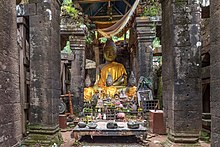This article includes a list of general references, but it lacks sufficient corresponding inline citations. (June 2020) |
The Anattalakkhaṇa Sutta (Pali) or Anātmalakṣaṇa Sūtra (Sanskrit), is traditionally recorded as the second discourse delivered by Gautama Buddha.[1] The title translates to the "Not-Self Characteristic Discourse", but is also known as the Pañcavaggiya Sutta (Pali) or Pañcavargīya Sūtra (Skt.), meaning the "Group of Five" Discourse.[2]

Contents
editIn this discourse, the Buddha analyzes the constituents of a person's body and mind (khandha) and demonstrates that they are each impermanent (anicca), subject to suffering (dukkha) and thus unfit for identification with a "self" (attan). The Pali version of this discourse reads:
- "Form, ... feeling, ... perception, ... [mental] fabrications, ... consciousness is not self. If consciousness were the self, this consciousness would not lend itself to dis-ease. It would be possible [to say] with regard to consciousness, 'Let my consciousness be thus. Let my consciousness not be thus.' But precisely because consciousness is not self, consciousness lends itself to dis-ease. And it is not possible [to say] with regard to consciousness, 'Let my consciousness be thus. Let my consciousness not be thus.'...
- "Thus, monks, any form, ... feeling, ... perception, ... fabrications, ... consciousness whatsoever that is past, future, or present; internal or external; blatant or subtle; common or sublime; far or near: every consciousness is to be seen as it actually is with right discernment as: 'This is not mine. This is not my self. This is not what I am.'
- "Seeing thus, the well-instructed disciple of the noble ones grows disenchanted with form, disenchanted with feeling, disenchanted with perception, disenchanted with fabrications, disenchanted with consciousness. Disenchanted, he becomes dispassionate. Through dispassion, he is fully released. With full release, there is the knowledge, 'Fully released.' He discerns that 'Birth is ended, the holy life fulfilled, the task done. There is nothing further for this world.'"[3]
In Buddhist canons
editIn the Pali Canon, the Anattalakkhana Sutta is found in the Samyutta Nikaya ("Connected Collection," abbreviated as either "SN" or "S") and is designated by either "SN 21.59" (SLTP) or "SN 22.59" (CSCD)[4] or "S iii 66" (PTS).[5] This discourse is also found in the Buddhist monastic code (Vinaya).[1]
In the Chinese set of Āgamas, this discourse can be found as Saṃyukta Āgama 34, or "SA 34".[6]
A version of this sutra, called the Aṇatvalakṣaṇa Sutra, is found among the Gāndhārī Buddhist Texts attributed to the Dharmaguptaka sect.[7]
See also
edit- Dhammacakkappavattana Sutta
- Anattā (Pali; Skt.: anātman; Eng.: "non-self")
- Three marks of existence: impermanence (anicca), suffering (dukkha) and non-self (anattā).
- Skandha (Skt.; Pali: khandha; Eng.: "aggregate") – Buddhist categories of body-mind constituents.
Notes
edit- ^ a b "Vinaya Texts, Part I (SBE 13) - Mahâvagga - First Khandaka". sacred-texts.com. Archived from the original on 25 August 2023. Retrieved 25 August 2023.
- ^ While, due to its content, this discourse is widely known as the Anattalakkhaṇa Sutta (e.g., see Mendis, 2007, Ñanamoli, 1993 Archived 22 December 2010 at the Wayback Machine, and CSCD SN 22.59 Archived 28 July 2011 at the Wayback Machine), this discourse is also known as the Pañcavaggiya Sutta (see Thanissaro, 1993, and SLTP SN 21.59 Archived 28 July 2020 at the Wayback Machine). The basis for this latter title is that the Buddha is addressing his original "group of five" (pañcavaggiya) disciples (Kondañña, Bhaddiya, Wappa, Mahanama and Assaji), all of whom become arahants upon hearing this discourse (Mhv 6:47) Archived 4 July 2011 at the Wayback Machine.
The first discourse traditionally ascribed to the Buddha is the Dhammacakkappavattana Sutta. - ^ Thanissaro (1993). Archived 11 October 2007 at the Wayback Machine (Square-bracketed text is in the source.)
- ^ "SN 22.59" denotes that this discourse is the fifty-ninth discourse in the 22nd group in the Samyutta Nikaya. Due to a different grouping of the SN suttas (e.g., in the SLTP, the CSCD's samyutta 13 is included as a final vaggo [chapter] in SLTP samyutta 12), this is samyutta 21 of the SLTP redaction and samyutta 22 of the CSCD redaction.
- ^ "S iii 66" denotes that, in the Pali Text Society edition of the Canon, this discourse starts on page 66 of the third volume of the Samyutta Nikaya. An example of this notation can be found in Thanissaro (1993).
- ^ Retrieved 16 December 2010 from "Sutta Central" at http://www.suttacentral.net/disp_correspondence.php?division_acronym=&sutta_number=59.0&sutta_coded_name=Anattalakkha%E1%B9%87a&volpage_info=SN%20III%2066&sutta_id=804.
- ^ "Aṇatvalakṣaṇa Sutra – Gandhāran Buddhist Texts". Retrieved 25 August 2023.
Sources
edit- Chaṭṭha Saṅgāyana CD (CSCD) (n.d.), "Khandhasaṃyuttaṃ" (SN 22). Retrieved 2010-12-29 from "The Pali Tipitaka" at http://tipitaka.org/romn/cscd/s0303m.mul0.xml.
- Mendis, N.K.G. (tr., ed.) (1979). On the No-self Characteristic: The Anatta-lakkhana Sutta (The Wheel No. 268). Kandy: Buddhist Publication Society. Retrieved 2007-10-03 from "Access to Insight" (2007) at http://www.accesstoinsight.org/lib/authors/mendis/wheel268.html.
- Ñanamoli Thera (tr., ed.) (1981). Three Cardinal Discourses of the Buddha (The Wheel No. 17). Kandy: Buddhist Publication Society. Retrieved 2007-10-03 from "Access to Insight" (1995) at http://www.accesstoinsight.org/lib/authors/nanamoli/wheel017.html.
- Rhys Davids, T.W. & Hermann Oldenberg (tr.) (1881). Vinaya Texts. Oxford: Clarendon Press. Retrieved 26 Sep 2007 from "Internet Sacred Texts Archive" at http://www.sacred-texts.com/bud/sbe13/index.htm.
- Sri Lanka Tripitaka Project (SLTP) (n.d.), "Upayavaggo" (SN 21.6). Retrieved 2010-12-19 from "MettaNet" at http://metta.lk/tipitaka/2Sutta-Pitaka/3Samyutta-Nikaya/Samyutta3/21-Khandha-Samyutta/02-01-Upayavaggo-p.html Archived 28 July 2020 at the Wayback Machine.
- Thanissaro Bhikkhu (tr.) (1993). Pañcavaggi Sutta: Five Brethren (SN 22.59). Retrieved 2010-12-29 from "Access to Insight" at http://www.accesstoinsight.org/tipitaka/sn/sn22/sn22.059.than.html.
External links
editTranslations
- The Characteristic of Nonself, translation by Bhikkhu Bodhi
- The Characteristic of Not-Self, translation by Bhikkhu Sujato
- "The Anātmalakṣaṇa Sūtra". Lapis Lazuli Texts. Retrieved 28 December 2010. From the Saṃyukta Āgama translated by Guṇabhadra (T02n99).
- "Anatta-lakkhana Sutta: The Discourse on the Not-self Characteristic". accesstoinsight.org. 2007. Retrieved 25 August 2023.